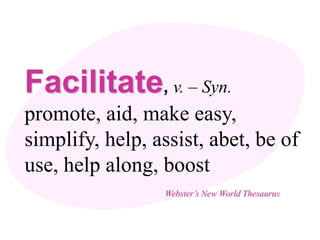
A Framework For Facilitation
- 1. Facilitate, v. – Syn. promote, aid, make easy, simplify, help, assist, abet, be of use, help along, boost Webster’s New World Thesaurus
- 2. The Context for Facilitative Work
- 4. Problem Decision Taking Solving Making Action
- 5. CONTENT PROCESS The What The How (Team Focus) (Facilitator Focus) Subject of discussion Methods Task Procedures Problem being solved Relationships Decision being made Tools Agenda items Rules / norms Outcomes Dynamics Climate
- 6. Problem Solving Open Open Narrow Close Narrow Close
- 7. Problem Decision Space Space Open Open Narrow Close Narrow Close Open Open Narrow Close Narrow Close Agree there is Agree to a Agree to Agree on criteria Agree on Agree on an issue and problem what the used to evaluate value of option the generate data statement. cause(s) solution options. each group is are. option. willing to Describe Generate support. what, options. Test where, options when and against how criteria. much.
- 8. What Facilitators Do …. Clarify outcomes “Park” off-topic items Support / suggest Create expectations Make interventions Paraphrase / Question Communicates Maintain energy Listen / respect Analyze context Set the tone Check for agreement Scan environment Keep on track / topic Show empathy Identify stakeholders Set the pace / tone Appropriately assertive Clarify roles Set an example Create focus Communicates Disclose feelings Stay flexible / optimistic Assemble resources Use peoples’ names Be informed / sensitive Make arrangements Model a “Win/Win” attitude Be alert / unobtrusive Plan contingencies Use Congruent non-verbals Surface concerns Review participation Be concise Watch the time Select processes Be candid Know when to stop Formulate agenda Create positive atmosphere Stay neutral Evaluate actions Communicates Monitor norms Evaluate outcomes Protect the Process Use tact / discretion Evaluate processes Ensure participation Clarify / Probe Communicate Manage Conflicts Summarize Recognize / thank
- 9. What Could Go Wrong ….. And how can I prevent it? Before the During the session: After the session session, get •Listen as an ally summarize: understanding and •Ask open ended questions •Agreements agreement on: •Be positive •Decisions •Desired outcomes •Provide clear instructions •Outcomes •Sponsor expectations •Check for understanding •Next steps •Decision making •Point out agreements •Ground rules •Drive “process stakes” •Agenda •Encourage participation •Context •Stay neutral •Environment •Monitor norms •Stakeholders •Use tact / discretion •Participants •Clarify / Probe •Roles •Summarize •Accountabilities •KPI’s •Level of participation
- 10. E High Involvement Delegate with Criteria Fallback D Act on Consensus Fallback Range of C Participation Decision Act with Team Input Making Options B Act with Individual Input “blue” figures have the “D” (decision rights) A Low Involvement Decide and Announce
- 11. Practices That Help Practices That Hinder Be attentive to group needs Be oblivious to group needs Personal sensitivity Don’t listen Maintain a “safe” atmosphere Lose track of ideas Create focus / purpose Take poor notes Be a servant to group Be the center of attention Keep it simple Get defensive Listen carefully Put down people Watch body language (yours too) Let conflict go unattended Help identify Let a few dominate Ensure participation Don’t ask how the session is going Remain neutral Impose your thoughts on the Maintain energy content Be flexible Let them get and stay off track Check understanding (yours too) Use only your favorite tools Summarize frequently Let it go on and on and on and on Be tool proficient (what/when) Be insensitive to cultural Focus on the outcomes differences Keep ownership with participants Use inappropriate humor
- 13. Problem Decision Space Space Tools Tools Open Open Narrow Close Narrow Close Open Open Narrow Close Narrow Close Perception Sharing What’s the Analyze data Output expected; N/3 Eliminate Affinity Diagram real problem? Develop Input available Category No-Go’s In Frame / Out of Lasso likely causes Criteria Setting Sort Combine / Frame What’s Test causes Brainstorm +/- Top Delete Threats / effected, More of / • Group several What would Opportunities where, when Less of •Silent Evaluate it take? … Fist to 5 •Write against Straw Poll •Pass criteria Both / And •Fishbowl Fist to 5